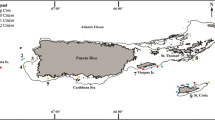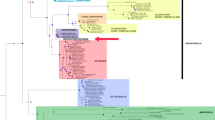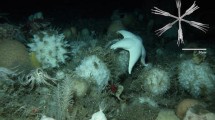Abstract
Octocorals, especially gorgonians, are conspicuous on Caribbean coral reefs, but there is no consensus regarding species relationships. Mitochondrial protein-coding genes [NADH-dehydrogenase subunits 2 (ND2) and 6 (ND6), and mutS homolog (msh1), 1633 bp] from 28 shallow-water species were sequenced to develop the first molecular phylogeny for Caribbean octocorals. The specimens were collected primarily in the Caribbean or off Brazil in 1999–2001. Morphological characters (sclerites and axial ultrastructure) were also examined in order to map them onto the molecular phylogeny. Analyses of both nucleotide and amino acid substitutions using maximum parsimony and likelihood (including maximum-likelihood and Bayesian analysis) generated very similar results, with most nodes having high levels of support. These molecular results were significantly different from the generally accepted classification. Neither Plexauridae nor Gorgoniidae were monophyletic. Plexaurella spp., nominal plexaurids, were basal to the gorgoniids, sharing many morphological characters with them. This corroborates previous findings using secondary metabolites and biosynthetic pathways. The sea fans, Gorgonia spp. and Pacifigorgia spp., as well as the pinnate gorgonians, Muriceopsis flavida and Pseudopterogorgia spp., did not have sea fan or pinnate relatives, suggesting there has been convergent evolution of colony form. Caribbean plexaurids appeared more derived and/or recently evolved according to both morphological and molecular data (e.g. Eunicea spp. and Plexaura spp.). Molecular phylogenetics is a promising approach for reconstructing phylogenetic relationships among octocorals as well as to understand their complex morphology. Electronic Supplementary Material is available if you access this article at http://dx.doi.org/10.1007/s00227-003-1018-7. On that page (frame on the left side), a link takes you directly to the supplementary material.







Similar content being viewed by others
References
Adachi J, Hasegawa M (1996) Model of amino acid substitution in proteins encoded by mitochondrial DNA. J Mol Evol 42:459–468
Bayer FM (1953) Zoogeography and evolution in the octocorallian family Gorgoniidae. Bull Mar Sci Gulf Caribb 3:100–119
Bayer FM (1956) Octocorallia. In: Moore RC (ed) Treatise of invertebrate paleontology, part F. Coelenterata. Geological Society of America and University of Kansas Press, Lawrence, pp 167–231
Bayer FM (1961) The shallow water Octocorallia of the West Indian region. Stud Fauna Curacao Other Caribb Isl 12:1-373
Bayer FM (1981) Key to the genera of Octocorallia exclusive of Pennatulacea (Coelenterata: Anthozoa), with diagnosis of new taxa. Proc Biol Soc Wash 94:902–947
Bayer FM (1991) Thelogorgia new-genus of gorgonacean octocorals with descriptions of four new species from the western Atlantic. Bull Mar Sci 49:506–537
Bayer FM (1992) The heloporacean octocoral Ephiphaxum, recent and fossil: a monographic iconography. Stud Trop Oceanogr 15:1–76
Bayer FM (2000) A new species of Leptogorgia from the eastern Pacific (Coelenterata: Octocorallia: Holaxonia). Proc Biol Soc Wash 113:609–616
Bayer FM, MacIntyre IG (2001) The mineral component of the axis and holdfast of some gorgonacean octocorals (Coelenterata: Anthozoa), with special reference to the family Gorgoniidae. Proc Biol Soc Wash 114:309–345
Bayer FM, Grasshoff M, Verseveldt J (eds) (1983) An illustrated trilingual glossary of morphological and anatomical terms applied to Octocorallia. Brill, Leiden, The Netherlands
Beaton MJ, Roger AJ, Cavalier-Smith T (1998) Sequence analysis of the mitochondrial genome of Sarcophyton glaucum: conserved gene order among octocorals. J Mol Evol 47:697–708
Berntson EA (1999) Evolutionary patterns within Anthozoa (phylum Cnidaria) reflected in ribosomal gene sequences. PhD thesis, MIT and Woods Hole Oceanographic Institution, Boston
Berntson EA, Bayer FM, McArthur AG, France SC (2001) Phylogenetic relationships within the Octocorallia (Cnidaria: Anthozoa) based on nuclear 18S rRNA sequences. Mar Biol 138:235–246
Boore JL (1999) Animal mitochondrial genomes. Nucleic Acids Res 27:1767–1780
Breedy O (2001) A new species of Pacifigorgia from the eastern Pacific (Coelenterata: Octocorallia: Gorgoniidae). Bull Biol Soc Wash 10:181–187
Coffroth MA, Lasker HR, Diamond ME, Bruenn JA, Bermingham E (1992) DNA fingerprints of a gorgonian coral: a method for detecting clonal structure in a vegetative species. Mar Biol 114:317–325
Culligan KM, Meyer-Gauen G, Lyons-Weiler J, Hays JB (2000) Evolutionary origin, diversification and specialization of eukaryotic MutS homolog mismatch repair proteins. Nucleic Acids Res 28:463–471
Filatov D (2001) Processor of sequences manual. University of Birmingham. Available at http://www.biosciences.bham.ac.uk/labs/filatov/proseq.html
France SC, Hoover LL (2001) Analysis of variation in mitochondrial DNA sequences (ND3, ND4L, MSH) among Octocorallia (=Alcyonaria) (Cnidaria: Anthozoa). Bull Biol Soc Wash 10:110–118
France SC, Hoover LL (2002) DNA sequences of the mitochondrial COI gene have low levels of divergence among deep-sea octocorals (Cnidaria: Anthozoa). Hydrobiologia 471:149–155
France SC, Rosel PE, Agenbroad JE, Mullineaux LS, Kocher TD (1996) DNA sequence variation of mitochondrial large-subunit rRNA provides support for a two-subclass organization of the Anthozoa (Cnidaria). Mol Mar Biol Biotechnol 5:15–28
Fu J, Murphy RW (1999) Discriminating and locating covariance: an application of permutation tail probability (PTP) analyses. Syst Biol 48:380–395
García-Parrado P, Alcolado P (1997) Nueva especie de Eunicea Lamouroux, 1816 (Plexauridae: Octocorallia) encontrada en Cuba. Avicennia 4/5:46–50
Gerhart DJ (1983) The chemical systematics of colonial marine animals: an estimated phylogeny of the order Gorgonacea based on terpenoid characters. Biol Bull (Woods Hole) 164:71–81
Goldberg W, Benayahu Y (1987) Spicule formation in the gorgonian coral Pseudoplexaura flagellosa. 1. Demonstration of intracellular and extracellular growth and the effect of ruthenium red during decalcification. Bull Mar Sci 40:287–303
Goldman N, Anderson JP, Rodrigo AG (2000) Likelihood-based tests of topologies in phylogenetics. Syst Biol 49:652–670
Grasshoff M (1988) The genus Leptogorgia (Octocorallia: Gorgoniidae) in West Africa. Atl Rep 14:91–147
Grasshoff M (1999) The shallow water gorgonians of New Caledonia and adjacent islands (Coelenterata: Octocorallia). Senkenb Biol 78:1–121
Grasshoff M, Alderslade P (1997) Gorgoniidae of Indo-Pacific reefs with description of two new genera (Coelenterata: Octocorallia). Senckenb Biol 77:23–35
Hall BG (2001) Phylogenetic trees made easy. Sinauer, Sunderland, Mass.
Hall TA (1999) BioEdit: a user-friendly biological sequence alignment editor and analysis program for Windows 95/98/NT. Nucleic Acids Symp Ser 41:95–98
Higgins DG, Thompson JD, Gibson TJ (1996) Using CLUSTAL for multiple sequence alignments. Meth Enzymol 266:383–402
Hillis DM, Bull JJ (1993) An empirical test of bootstrapping as a method for assessing confidence in phylogenetic analysis. Syst Biol 142:182–192
Hillis DM, Huelsenbeck JP (1992) Signal, noise, and reliability in molecular phylogenetic analysis. J Hered 83:189–195
Huelsenbeck JP, Ronquist F (2001) MrBayes: a program for the Bayesian inference of phylogeny. Available from http://morphbank.ebc.uu.se/mrbayes/manual.pdf
Kingsley RJ, Watabe N (1982) Ultrastructural investigation of spicule formation in the gorgonian Leptogorgia virgulata (Lamarck) (Coelenterata: Gorgonacea). Cell Tissue Res 239:305–310
Kükenthal W (1919) Gorgonaria. Wiss Ergebn Dt Tiefsee-Exped "Valdivia" 13
Lasker HR, Kim K, Coffroth MA (1996) Reproductive and genetic variation among gorgonians: the differentiations of Plexaura kuna, new species. Bull Mar Sci 58:277–288
Lewis JC, Von Wallis E (1991) The function of surface sclerites in gorgonians (Coelenterata, Octocorallia). Biol Bull (Woods Hole) 181:275–288
Linnaeus C (1758) Systema Naturae. I. Editio decima, reformata. Holmiae
Macintyre IG, Bayer FM, Logan MAV, Skinner HCW (2000) Possible vestige of early phosphatic biomineralization in gorgonian octocorals (Coelenterata). Geology 28:455–458
Malik HS, Henikoff S (2000) Dual recognition-incision enzymes might be involved in mismatch repair and meiosis. Trends Biochem Sci 25:414–418
McFadden CS, Tullis ID, Hutchinson MB, Winner K, Sohm JA (in press) Variation in coding (NADH dehydrogenase subunits 2, 3 and 6) and non-coding intergenic spacer regions of the mitochondrial genome in Octocorallia (Cnidaria: Anthozoa). Mar Biotechnol
Medina M, Weil E, Szmant AM (1999) Examination of the Montastraea annularis species complex (Cnidaria: Scleractinia) using ITS and COI sequences. Mar Biotechnol 1:89–97
Mickevich MF, Johnson MF (1976) Congruence between morphological and allozyme data. Syst Zool 25:260–270
Pont-Kingdon GA, Okada NA, Macfarlane JL, Beagley CT, Wolstenholme DR, Cavalier-Smith T, Clark-Walker GD (1995) A coral mitochondrial mutS gene. Nature 375:109–111
Pont-Kingdon G, Okada N, Macfarlane AJL, Beagley CT, Watkins-Sims CD, Cavalier-Smith T, Clark-Walker GD, Wolstenholme DR (1998) Mitochondrial DNA of the coral Sarcophyton glaucum contains a gene for a homologue of bacterial MutS: a possible case of gene transfer from the nucleus to the mitochondrion. J Mol Evol 46:419–431
Posada D, Crandall KA (1998) MODELTEST: testing the model of DNA substitution. Bioinformatics 14:817–818
Posada D, Crandall KA (2001) Selecting the best-fit model of nucleotide substitution. Syst Biol 50:580–601
Sánchez JA (1998) Systematics of the Caribbean candelabrum octocorals (Eunicea Lamouroux, 1816; Cnidaria; Octocorallia; Gorgonacea; Plexauridae) with description of new species and some aspects of their natural history. MS thesis, National University of Colombia, Bogotá
Sánchez JA (1999) Black coral–octocoral distribution patterns on a deep-water reef, Imelda bank, Caribbean Sea, Colombia. Bull Mar Sci 65:215–225
Sánchez JA (2001) Systematics of the southwestern Caribbean Muriceopsis Aurivillius (Cnidaria: Octocorallia) with description of a new species. Bull Biol Soc Wash 10:160–180
Sánchez JA, Zea S, Diaz JM (1997) Gorgonian communities of two contrasting environments from oceanic Caribbean atolls. Bull Mar Sci 61:61–72
Sánchez JA, Diaz JM, Zea S (1998) Octocoral and black coral distribution patterns on the barrier reef-complex of Providencia Island, southwestern Caribbean. Caribb J Sci 34:250–264
Sánchez JA, Lasker HR, Taylor DJ (in press) Phylogenetic analyses among octocorals (Cnidaria) according to mitochondrial and nuclear DNA sequences (lsu-rRNA 16S, and ssu-rRNA 18S) support two convergent clades of branching gorgonians. Mol Phylogenet Evol
Strimmer K, von Haeseler A (1996) Quartet puzzling: a quartet maximum likelihood method for reconstructing tree topologies. Mol Biol Evol 13:964–969
Swiderski DL, Zelditch ML, Fink WL (1998) Why morphometrics is not special: coding quantitative data for phylogenetic analysis. Syst Biol 47:508–519
Swofford DL (2002) PAUP*: phylogenetic analysis using parsimony (*and other methods), version 4.0b10. Sinauer, Sunderland, Mass.
Van Oppen MJH, Willis BL, Miller DJ (1999) Atypically low rate of cytochrome b evolution in the scleractinian coral genus Acropora. Proc R Soc Lond B Biol Sci 266:179–179
Williams GC, Vennam JS (2001) A revision of the Indo–West Pacific taxa of the gorgonian genus Pseudopterogorgia (Octocorallia: Gorgoniidae), with the description of a new species from western India. Bull Biol Soc Wash 10:71–95
Acknowledgements
J.A. Sánchez acknowledges the Society of Systematic Biologists awards for graduate students (2000), the Lerner-Gray Grant, American Museum of Natural History (2001), Fulbright-Laspau-COLCIENCIAS doctoral scholarship (1998–2002), the Smithsonian Institution short-term visitor fellowship (2001), and the Graduate Group in Evolutionary Biology and Ecology, UB (SUNY), for their support. Additional funding for the project came from grants to H.R.L. from the New York Sea Grant Institute (R/XG-9) and National Undersea Research Center, Caribbean Marine Research Center (CMRC 99-3301). We specially thank M.A. Coffroth for providing laboratory resources. Comments from and discussions with C. Mitchell, D.J. Taylor, S.D. Cairns, M.A. Coffroth, G. Yan, and two anonymous reviewers greatly improved the manuscript. A.D. Rodriguez (U. Puerto Rico), J. Pawlik (UNCW), and W. Fenical (Scripps) provided support for field trips. Assistance from C. Gutierrez-Rodriguez, S. Santos, T. Swain, T. Shearer, and M. Boller greatly helped during field collections and laboratory analyses. Thanks to M. Semeraro and C. Castro (Phyllogorgia dilatata), Brazil, A. Brash (Vanderbilt University, Plexaura homomalla), and W. O'Neal (UNCW, Leptogorgia virgulata) for providing material. P. Bush (UB-SUNY, Inst. Center), S. Whittaker, and S. Braden (Scanning Electron Laboratory, NMNH, Smithsonian Institution) assisted with SEM analyses.
Author information
Authors and Affiliations
Corresponding author
Additional information
Communicated by J.P. Grassle, New Brunswick
Electronic Supplementary Material is available if you access this article at http://dx.doi.org/10.1007/s00227-003-1018-7. On that page (frame on the left side), a link takes you directly to the supplementary material.
Rights and permissions
About this article
Cite this article
Sánchez, J.A., McFadden, C.S., France, S.C. et al. Molecular phylogenetic analyses of shallow-water Caribbean octocorals. Marine Biology 142, 975–987 (2003). https://doi.org/10.1007/s00227-003-1018-7
Received:
Accepted:
Published:
Issue Date:
DOI: https://doi.org/10.1007/s00227-003-1018-7




